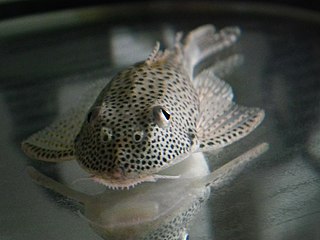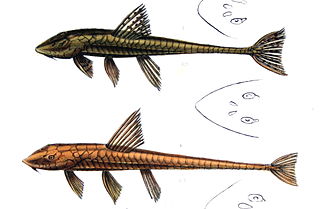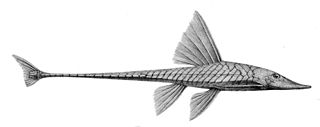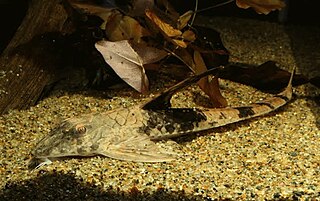
Ancistrus is a genus of nocturnal freshwater fish in the family Loricariidae of order Siluriformes, native to freshwater habitats in South America and Panama. Fish of this genus are common in the aquarium trade where they are known as bushynose or bristlenose catfish. In the aquarium hobby they are often referred to as bushynose or bristlenose plecos instead, but this may lead to confusion as "pleco" usually is used for Hypostomus plecostomus and its allies and is often used as a catchall term for any loricariids remotely resembling that species.

Otocinclus is a genus of catfish in the family Loricariidae native to South America, commonly known as "dwarf suckers" or "otos". This genus, like other loricariids, is characterized by rows of armour plating covering the body, as well as the underslung suckermouth. They are generally small in size; O. tapirape is the smallest of the species (2.4 cm), while O. flexilis is the biggest (5.5 cm). These species have adaptations that allow them to breathe air. A duct forms at the junction between the esophagus and the stomach and expands into an enlarged, ring-like diverticulum, characteristic of this genus, which allows air-breathing. Otocinclus are popular aquarium fish, and they are often purchased as algae eaters. It is difficult to breed them in captivity, and only wild caught Otocinclus are available to hobbyists. This genus is widely distributed east of the Andes of South America, throughout the lowlands from northern Venezuela to northern Argentina, but are generally absent from the Amazon and the Orinoco lowlands.

Aphanotorulus is a genus of armored catfishes native to the Amazon, Orinoco, Essequibo and Jaguaribe basins in South America. They typically occur on a sand or gravel bottom in slow to moderately flowing rivers and streams, but some species occur in areas with fast current. The largest species in the genus reaches up to 51 cm (20 in) in standard length.

Rineloricaria is a genus of freshwater tropical catfish belonging to the family Loricariidae. They are commonly called whiptail catfish because of the long filament that grows out of the tip of the caudal fin that is characteristic of the genus. With the exception of R. altipinnis from Panama, they are native to the rivers of northern and central South America. Some species are regularly seen in the aquarium trade.

Loricariichthys is a genus of catfishes of the family Loricariidae.

Sturisoma is a genus of armored catfishes native to Central and South America.
Harttia is a genus of armored catfishes native to South America.

Loricaria is a genus of armored catfish native to South America.
Neoplecostomus is a genus of fish in the family Loricariidae native to South America. Neoplecostomus can be distinguished from all other loricariids by a modified shield of small plates on the abdomen with posteriorly directed odontodes; the shield appears to act as a holdfast. The color pattern is generally mottled brown with the abdomen white. The head is long, rounded, and shovel-shaped. The fin spines are weak. They range from about 8 to 11 cm (3.1–4.3 in) SL. The species of Neoplecostomus live in fast-flowing water.

Sturisomatichthys is a genus of armored catfishes native to Central and South America.
Pseudohemiodon is a genus of armored catfishes native to South America.

Spatuloricaria is a genus of armored catfishes native to South America and Panama.

Bunocephalus is a genus of banjo catfishes from South America. It is found in Magdalena, Orinoco, Amazon, Paraguay-Paraná, and São Francisco Rivers. It is also the only aspredinid genus found west of the Andes, found in the Atrato, San Juan, and Patía Rivers. This genus is a part of the family Aspredinidae, known as banjo catfishes for their large, flattened heads and slender tails that give the appearance of a banjo. Most species exhibit cryptic coloration, and the same holds true among Bunocephalus species. The skin is completely keratinized and is covered by large, unculiferous tubercles. Bunocephalus species may reach up to 13 centimetres SL.
Farlowella schreitmuelleri is a species of armored catfish endemic to Brazil where it is found in the lower Amazon basin. This species grows to a length of 18.1 centimetres (7.1 in) SL.

Chaetostoma, also known as the bristlemouth catfish, is a genus of suckermouth armored catfishes native to South America with one species, C. fischeri, extending into Panama. Most species inhabit flowing rivers in the lower Andes and its foothills. Some species are kept in unheated aquaria.
Chaetostoma joropo is a species of catfish in the family Loricariidae. It is native to South America, where it occurs in the Cusiana River basin in the Orinoco drainage in Colombia. The species reaches at least 12.47 cm SL and was described in 2016 by Gustavo A. Ballen of the University of London, as well as Alexander Urbano-Bonilla and Javier A. Maldonado-Ocampo of the Pontifical Xavierian University. It appears in the aquarium trade, where it is frequently referred to by its L-number, which is L-445. This species has reportedly been known to aquarists for quite some time prior to its 2016 scientific description.
Chaetostoma platyrhynchus is a species of catfish in the family Loricariidae. It is native to South America, where it occurs in the Caquetá River basin in Colombia. The species reaches 9.5 cm in total length. The species is known to be of disputed classification and spelling.
Farlowella yarigui is a species of catfish in the family Loricariidae. It is native to South America, where it occurs in the Topón River, which is part of the middle Magdalena River basin in Colombia. It is only found in the vicinity of partially submerged vegetation and pieces of wood, with the species being absent in other microhabitats within the main channel of the Topón. It is known to occur alongside the species Astyanax caucanus, Astyanax magdalenae, Astyanax filiferus, Lasiancistrus caucanus, and Roeboides dayi, as well as members of the genera Chaetostoma, Creagrutus, Hemibrycon, and Sturisoma. The species reaches 11.2 cm in standard length and is believed to be a facultative air-breather.
Farlowella mitoupibo is a species of catfish in the family Loricariidae. It is native to South America, where it occurs in the upper Guaviare River, which is part of the Orinoco basin in Colombia. The species reaches at least 20.96 cm in standard length. It was described in 2016 by Gustavo A. Ballen, Alexander Urbano-Bonilla, and Jhon Zamudio. Its specific name, mitoupibo, is derived from the Guahibo name for the species. FishBase does not yet list this species.
Farlowella gianetii is a species of catfish in the family Loricariidae. It is native to South America, where it occurs in the upper Xingu River basin in the state of Mato Grosso in Brazil. The species reaches at least 12.1 cm in standard length. It was described in 2016 by Gustavo A. Ballen, Murino N. L. Pastana, and Luiz Peixoto. Its specific name, gianetii, honors Dr. Michel Donato Gianeti, manager of the ichthyological collections of the University of São Paulo. FishBase does not yet list this species.











